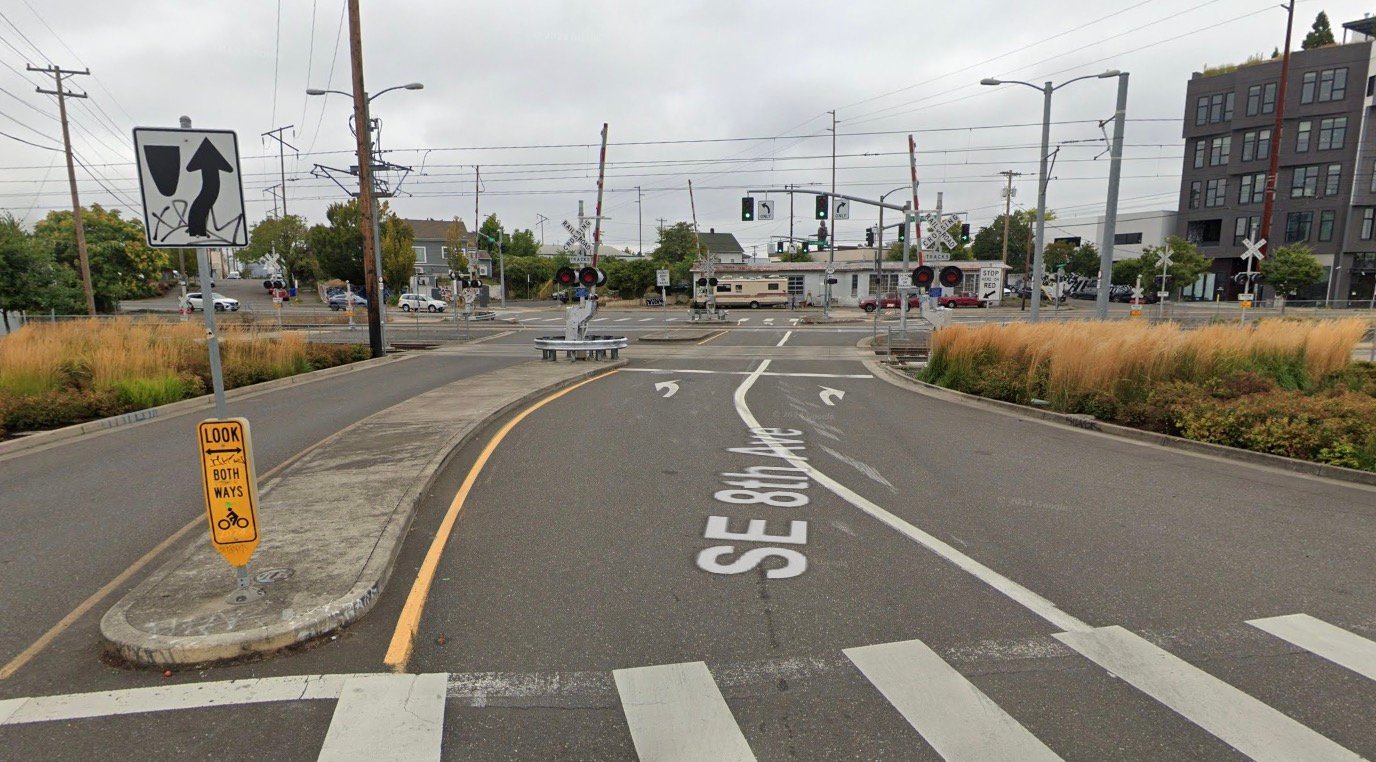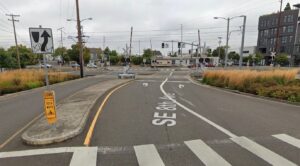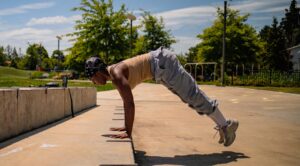A Look at The Dump’s Artist Residency

Each year, the Glean artist residency gives five artists five months of unfettered access to the Metro Central Transfer Station (a.k.a. the dump) and hosts a culminating exhibition. Pictured here, mai ide mends discarded textiles into sculptural corsets.
Epiphany Couch culled photographs, mop heads, some light fixtures, a box of beads, books, and a couple wood panels. She was still looking for thread when we spoke. Chris Lael Larson was up to his ears in paint, ink cartridges, and bright plastics. His workbenches were a tangle of children’s toys and vacuum hoses, presided over by a pea-green watering can the shape of a gnome. Rugs and safety cones filled mai ide’s studio when I visited in March.
Couch, Larson, and ide, along with fellow artists Diane Jacobs and Marsha Mack, make up the 2025 Glean Residency cohort. The annual program gives five artists $2,000 and five months of privileged access to the city’s collected garbage, which makes up at least 95 percent of the art on view in a culminating exhibition at a temporary gallery space in the Park Blocks (322 NW Eighth Ave, April 17 to May 25).
Especially in the visual art world, this formula can yield contrived results. But Glean has a reputation for compelling shows. Rather than bonking viewers over the head with a moral warning against waste, the work stands on its own. Carrying out the program’s mission through proof-of-concept rather than gimmick pushes both artists and audiences toward more nuanced conversations of waste reduction. This is, after all, an exhibition of art objects made from—at least theoretically—the audience’s own refuse.

The 2025 Glean cohort: mai ide (left), Diane Jacobs, Marsha Mack, Chris Lael Larson, Epiphany Couch.
The organization’s program manager and sole employee Leslie Vigeant says attendees are generally “excited about the alchemy of trash-to-art,” even if they don’t consider themselves rabid environmentalists. More than transforming garbage into treasure, or whichever cliché you like, Vigeant says the conceit winds up being something like: “Maybe this trash isn’t trash.”
An employee-owned resource recovery company called Recology launched the Glean residency in San Francisco in 1990. Today, there are residencies at Recology centers along the West Coast, though Portland’s was the first offshoot and is now in its 14th year. Recology still funds the program in a partnership with Metro, the government group overseeing Portland’s garbage and recycling system. ReClaim It, an environmental arts nonprofit, chips in too.
In February, I visited Couch’s studio to see what the program looks like in practice. She saw people in the thrown-away objects, and inferred narratives as she witnessed personal possessions become nondescript trash in the wake of encampment sweeps, floods, evictions, and other devastations. She glimpsed a cache of legal documents amid the refuse of one sweep. Another day, she saw all the trappings of what looked like a brand-new nursery.

A collage of found photographs by Epiphany Couch.
She showed me a collage she made of found photos. Carefully snipped into triangles and diamonds, the images were affixed to salvaged wood in a pattern derived from Salish weavings believed to transform and protect. Here, the pattern honored the anonymized moments, dreams, and memories the pictures held.
Couch’s use of photo collage and Indigenous craftways speaks to another special attribute of this reuse-based residency: the diversity of its artists. Glean artists live in Multnomah, Washington, and Clackamas counties and hail from a range of demographic groups and artistic disciplines. They are sculptors, photographers, and installation artists first, recyclers second, which makes for conceptually sound artworks that are more than the sum of their rusty pipes and soiled fabric scraps.
For example, Larson’s abstract assemblages, whose color and form evoke childhood mischief for even the most uninitiated contemporary art appreciator, hardly carry a whiff of the dump. “That’s no easy feat,” Vigeant says, and should know, as she was one of the program’s first artist-participants in 2011. Larson set out to critique careless consumerism but quickly felt critical of companies that make “all this stuff”: the crime of “cranking out a million little plastic action figures” and single-use containers destined for a landfill. As we talked in his studio, a figure from the Sonic the Hedgehog franchise watched from one of his works on the wall.

A brightly colored assemblage of repurposed plastics, ink, and wood panels by Chris Lael Larson.
Larson’s pieces are shockingly ebullient 3D wonderlands of neon whatsits. Plastic toy parts and cheap home organization solutions are layered with blobs of wood and lurid paper cutouts printed with those found ink cartridges. The work is “a little bit contrarian,” he says. “Part of me thinks it’s funny to go someplace that is that gnarly and smells bad and is very dangerous and make something…” he trailed off and we both laughed at the tension between a jaunty, palm-tree-topped sculpture and the tragic reality of trash.
The freedom to make work that’s not necessarily “about” trash helps avoid what Larson calls, euphemistically, “expected outputs,” giving the example of fashion shows where designers make clothes from plastic bottles. “We can probably all imagine what all those dresses would look like,” he says.
While she didn’t make any plastic-bottle dresses, ide, who works primarily in textiles, did seek out items she could mend at the dump. “I always feel that society doesn’t know how to deal with brokenness, [in] both human beings and objects,” she told me in an email after our studio visit. “When I see abused, discarded objects, I feel affinity with them as a broken entity, an ignored Asian body, as disposable labor or even an object.”
For Glean, ide created a series of traffic cones wrapped in an eccentric mix of commonly disposed fabrics: carpet padding, faux fur, the body of a fabric doll, and welcome mats. The cones represent social repression and restriction of movement. She’s thinking particularly about women, about mothers, about how her own parents are critical of her choice to work as a full-time artist while her children are still young. I bent to inspect a cone covered in bubble wrap. A rug’s excised fringe skirted its base. Did I like the mirror at the end of the row? ide asked. It reflected the patterned cones back toward our feet: an infinite line that, I told her, reminded me of the way social rules sometimes feel endless or double-bound.

A corset made from discarded rugs by mai ide.
Later, ide showed me a corset she made from one of the discarded rugs. Without a cinch, it hung by its straps, flayed open. Its pattern and decorative fringe squarely conveyed its origin as a mat for wiping one’s feet. Like the cones, it called for a specific set of behaviors: stop, stomp, get clean before entering. These understood dictates applied in this new, corseted form suggested the similarities between a sexy, constricting garment for women and an object intended to be used, sullied, and eventually discarded. We had a lively discussion about whether the piece should be hung like a garment or laid on the floor like a carpet.
Share this content:














Post Comment